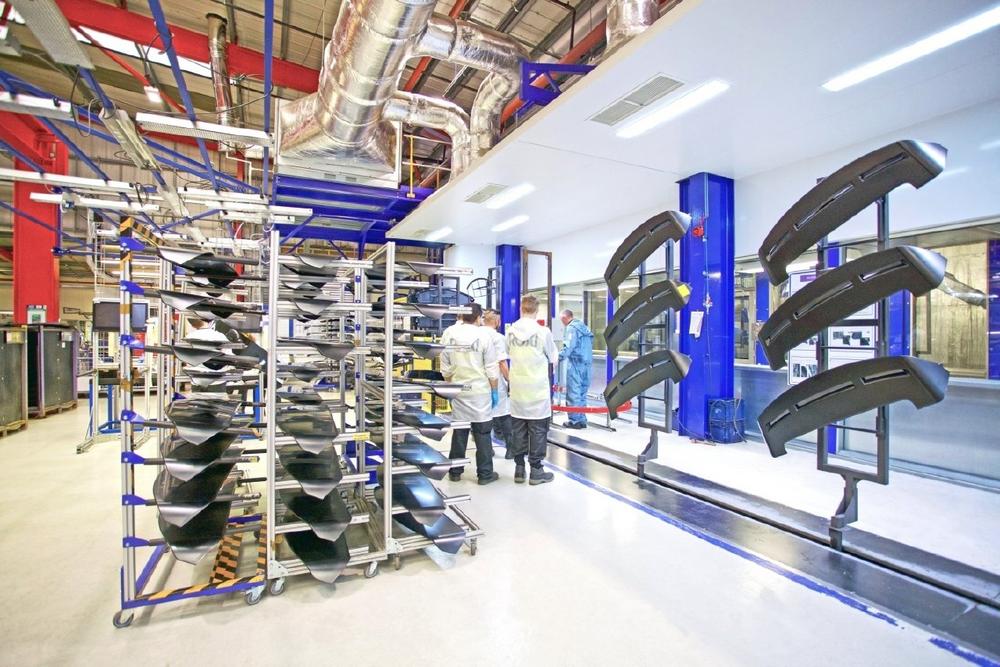As with metallic components, plastic components have long been cleaned with powerwash systems prior to painting. The components first pass through a cleaning step with a mostly alkaline medium, followed by several rinsing zones, an adhesive water dryer and a cooling zone. Cleaning not only takes up a lot of production space, but also consumes large quantities of resources. Furthermore, plastic components behave differently from their metal counterparts. The heat introduced during the cleaning step causes the plastic parts to expand, with the result that water is stored. During the drying process, the parts are heated once again. This could be one reason why some of the ingredients used to make the plastic, such as separating agents, additives or fillers, which have migrated upwards from deeper layers, can later be found on the cleaned surface and impair paint adhesion.
Dry cleaning with consistently good results
In contrast to wet-chemical processes, the quattroClean system from acp systems AG, which has been used frequently for this task for years, uses a dry cleaning technology. The cleaning medium is liquid carbon dioxide, which has an almost indefinite shelf life. It is environmentally neutral, generated as a by-product in the chemical industry, as well as when energy is generated from biogas.
The non-combustible, non-corrosive and non-toxic carbon dioxide is fed through the acp system’s non-wearing two-component ring nozzle and expands on exiting to form fine CO2 snow crystals. These are then bundled by a jacketed jet of compressed air and accelerated to supersonic speed. When the non-abrasive jet of snow and compressed air impacts on the surface to be cleaned at a temperature of minus 78.5°C, a combination of thermal, mechanical, sublimation and solvent effects occur. Thanks to these four effective cleaning mechanisms, the quattroClean system reliably and reproducibly removes particulate and filmic contamination from the entire surface or, if required, only from a specific area. The cleaning process is so gentle on materials that it can even be used to clean delicate and finely-structured surfaces.
The aerodynamic force of the compressed air carries away the detached impurities, which are then extracted by an integrated suction unit to prevent recontamination. Since CO2 sublimates instantly at atmospheric pressure, at the end of the cleaning process components are dry, enabling them to be ionized, activated or painted straightaway. A further advantage of the dry cleaning process is the resulting greater design freedom for parts because geometries where fluid could become trapped are no longer a problem.
Major savings and fully-automated operation
In addition to the high and consistent cleaning performance, significantly lower investment and operating costs, as well as much less space, are required for the chemical-free quattroClean process. It can be space-savingly integrated into a cabin – comparable to a spray booth.
Another advantage of the cleaning system is its modular design, which allows it to be optimally adapted to any application. Depending on requirements, one or more nozzle arrays are used when the system is integrated into a painting line. The cleaning process can be automated using robots, linear or gantry systems. All process parameters, such as the consumption of compressed air and carbon dioxide, blasting time, blasting angle and motion sequence – including 3D movements – can be precisely matched to the respective part to be coated and stored as cleaning programs in the control system. Since the cleaning process is very similar to the painting process with robots, almost identical programming solutions can be used. In addition, the effective range of the nozzle array can be automatically scaled according to the geometry of the workpiece concerned. Via interfaces such as Profibus or Profinet, the industry 4.0-capable cleaning system can also be integrated into the painting line’s control system, or into the production control system.
Contact: acp systems AG, www.acp-systems.com
Founded in Stuttgart in 1997, acp systems AG is today one of the international market and technology leaders for efficient CO2 snow jet cleaning. The company’s patented quattroClean technology enables dry, material and resource-saving removal of particulate contaminants and film-type residues from virtually all engineering materials. The dry process also opens up the opportunity to clean electronic and electromechanical components. The scalable and Industry 4.0 capable quattroClean process can be easily adapted to different component geometries for full-surface or partial cleaning, e.g. where sealants and adhesives are applied or for welding, bonding, coating or assembly steps. Another core competence of acp is the automation of cleaning processes and their integration into linked production, assembly and coating lines.
acp systems AG
Berblingerstr. 8
71254 Ditzingen
Telefon: +49 (7156) 48014-0
Telefax: +49 (7156) 48014-10
http://www.acp-systems.com
PR Beartung
E-Mail: ds@pressetextschulz.de
